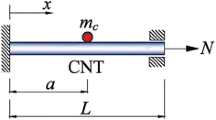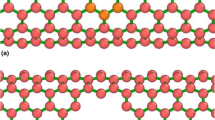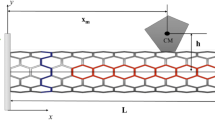Abstract
In this study, a finite element formulation is presented to analyze the free vibration of carbon nanotube based sensor in conjunction with modified couple stress and Rayleigh beam theories. Rotary inertia effect and size dependency are considered for vibration problem of the cantilever single walled carbon nanotube. The aim of this paper is to examine the vibrational frequencies of single-walled carbon nanotube with these effects. Therefore, for the finite element solution, stiffness and mass matrices have been obtained that include these effects in the calculations. Numerical results are presented to show the variation of the frequencies with a variety of parameters such as the material length scale parameter, number of the finite elements, length of the nanotube and mode number.










Similar content being viewed by others
References
Abdellah A, Abdelhalim A, Loghin F, Kohler P, Ahmad Z, Scarpa G, Lugli P (2013) Flexible carbon nanotube based gas sensors fabricated by large-scale spray deposition. IEEE Sens J 13(10):4014–4021. https://doi.org/10.1109/jsen.2013.2265775
Akbarzadeh Khorshidi M, Shariati M, Emam SA (2016) Postbuckling of functionally graded nanobeams based on modified couple stress under general beam theory. Int J Mech Sci 110:160–169
Akbas SD (2016) Analytical solutions for static bending of edge cracked micro beams. Struct Eng Mech 59(3):579–599
Akbaş ŞD (2017) Free vibration of edge cracked functionally graded microscale beams based on the modified couple stress theory. Int J Struct Stab Dyn 17(03):1750033
Akbaş ŞD (2018a) Bending of a cracked functionally graded nanobeam. Adv Nano Res 6(3):219
Akbaş ŞD (2018b) Forced vibration analysis of cracked nanobeams. J Braz Soc Mech Sci Eng 40(8):392
Akbaş ŞD (2019) Axially forced vibration analysis of cracked a nanorod. J Comput Appl Mech 50(1):63–68
Akbas SD (2020) Modal analysis of viscoelastic nanorods under an axially harmonic load. Adv Nano Res 8(4):277–282
Akgöz B, Civalek Ö (2011) Strain gradient elasticity and modified couple stress models for buckling analysis of axially loaded micro-scaled beams. Int J Eng Sci 49(11):1268–1280
Akgöz B, Civalek Ö (2014) Longitudinal vibration analysis for microbars based on strain gradient elasticity theory. J Vib Control 20(4):606–616
Akgöz B, Civalek Ö (2017) Effects of thermal and shear deformation on vibration response of functionally graded thick composite microbeams. Compos B Eng 129:77–87
Chang WJ, Lee HL (2009) Free vibration of a single-walled carbon nanotube containing a fluid flow using the Timoshenko beam model. Phys Lett A 373(10):982–985
Civalek Ö (2020) Vibration of functionally graded carbon nanotube reinforced quadrilateral plates using geometric transformation discrete singular convolution method. Int J Numer Meth Eng 121(5):990–1019
Civalek Ö, Demir C (2016) A simple mathematical model of microtubules surrounded by an elastic matrix by nonlocal finite element method. Appl Math Comput 289:335–352
Civalek O, Jalaei MH (2020) Buckling of carbon nanotube (CNT)-reinforced composite skew plates by the discrete singular convolution method. Acta Mech 231:2565–2587
Civalek Ö, Uzun B, Yaylı MÖ, Akgöz B (2020) Size-dependent transverse and longitudinal vibrations of embedded carbon and silica carbide nanotubes by nonlocal finite element method. Eur Phys J Plus 135(4):381
Demir C, Civalek Ö (2013) Torsional and longitudinal frequency and wave response of microtubules based on the nonlocal continuum and nonlocal discrete models. Appl Math Model 37(22):9355–9367
Duan WH, Wang CM, Zhang YY (2007) Calibration of nonlocal scaling effect parameter for free vibration of carbon nanotubes by molecular dynamics. J Appl Phys 101(2):024305
Ebrahimi F, Barati MR, Civalek Ö (2019) Application of Chebyshev-Ritz method for static stability and vibration analysis of nonlocal microstructure-dependent nanostructures. Eng Comput. 1:1–12
Elishakoff I, Dujat K, Muscolino G, Bucas S, Natsuki T, Wang CM, Zhang Y (2013) Carbon nanotubes and nanosensors: vibration. John Wiley & Sons, Buckling and Balistic Impact
Ersoy H, Numanoğlu HM, Akgöz B, Civalek Ö (2018) Small size and rotary inertia effects on the natural frequencies of carbon nanotubes. Curved Layer Struct 5(1):273–279
Fang J, Gu J, Wang H (2018) Size-dependent three-dimensional free vibration of rotating functionally graded microbeams based on a modified couple stress theory. Int J Mech Sci 136:188–199
Farzam A, Hassani B (2019) Size-dependent analysis of FG microplates with temperature-dependent material properties using modified strain gradient theory and isogeometric approach. Compos B Eng 161:150–168
Ghadiri M, Shafiei N (2016) Vibration analysis of rotating functionally graded Timoshenko microbeam based on modified couple stress theory under different temperature distributions. Acta Astronaut 121:221–240
Gorgani HH, Adeli MM, Hosseini M (2019) Pull-in behavior of functionally graded micro/nano-beams for MEMS and NEMS switches. Microsyst Technol 25(8):3165–3173
Hosseini M, Bahaadini R (2016) Size dependent stability analysis of cantilever micro-pipes conveying fluid based on modified strain gradient theory. Int J Eng Sci 101:1–13
Iijima S (1991) Helical microtubules of graphitic carbon. Nature 354(6348):56–58
Ilkhani MR, Hosseini-Hashemi SH (2016) Size dependent vibro-buckling of rotating beam based on modified couple stress theory. Compos Struct 143:75–83
Jacobs CB, Peairs MJ, Venton BJ (2010) Review: carbon nanotube based electrochemical sensors for biomolecules. Anal Chim Acta 662(2):105–127. https://doi.org/10.1016/j.aca.2010.01.009
Jia X, Ke L, Zhong X, Sun Y, Yang J, Kitipornchai S (2018) Thermal-mechanical-electrical buckling behavior of functionally graded micro-beams based on modified couple stress theory. Compos Struct 202:625–634
Jorio A, Dresselhaus G, Dresselhaus MS (eds) (2007) Carbon nanotubes: advanced topics in the synthesis, structure, properties and applications, vol 111. Springer, Berlin
Jouneghani FZ, Babamoradi H, Dimitri R, Tornabene FA (2020) A modified couple stress elasticity for non-uniform composite laminated beams based on the ritz formulation. Molecules 25(6):1404
Kong S, Zhou S, Nie S, Wang K (2008) The size-dependent natural frequency of Bernoulli-Euler micro-beams. Int J Eng Sci 46:427–437
Li Y, Pan ES (2015) Static bending and free vibration of a functionally graded piezoelectric microplate based on the modified couple-stress theory. Int J Eng Sci 97:40–59
Ma HM, Gao X-L, Reddy JN (2008) A microstructure-dependent Timoshenko beam model based on a modified couple stress theory. J Mech Phys Solids 56:3379–3391
Ma HM, Gao X-L, Reddy JN (2011) A non-classical Mindlin plate model based on a modified couple stress theory. Acta Mech 220:217–235
Mahmoud FF, Eltaher MA, Alshorbagy AE, Meletis EI (2012) Static analysis of nanobeams including surface effects by nonlocal finite element. J Mech Sci Technol 26(11):3555–3563
Mercan K, Civalek Ö (2017) Buckling analysis of Silicon carbide nanotubes (SiCNTs) with surface effect and nonlocal elasticity using the method of HDQ. Compos B Eng 114:34–45
Miandoab EM, Yousefi-Koma A, Pishkenari HN (2015) Nonlocal and strain gradient based model for electrostatically actuated silicon nano-beams. Microsyst Technol 21(2):457–464
Mohammadimehr M, Mahmudian-Najafabadi M (2013) Bending and free vibration analysis of nonlocal functionally graded nanocomposite timoshenko beam model rreinforced by swbnnt based on modified coupled stress theory. J Nanostruct 3:483–492
Obitayo W, Liu T (2012) A review: carbon nanotube-based piezoresistive strain sensors. J Sens 2012:1–15. https://doi.org/10.1155/2012/652438
Peng N, Zhang Q, Chow CL, Tan OK, Marzari N (2009) Sensing mechanisms for carbon nanotube based NH3Gas detection. Nano Lett 9(4):1626–1630. https://doi.org/10.1021/nl803930w
Rahaeifard M, Ahmadian M, Firoozbakhsh K (2015) Vibration analysis of electrostatically actuated nonlinear microbridges based on the modified couple stress theory. Appl Math Model 39(21):6694–6704
Reddy JN (2002) Energy principles and variational methods in applied mechanics, 2nd edn. John Wiley and Sons, New York
Roy S, David-Pur M, Hanein Y (2017) Carbon nanotube-based ion selective sensors for wearable applications. ACS Appl Mater Interfaces 9(40):35169–35177. https://doi.org/10.1021/acsami.7b07346
Schrlau M (2011) Carbon nanotube-based sensors: overview. Compr Biomater 3:519–528. https://doi.org/10.1016/B978-0-08-055294-1.00120-3
Shafiei N, Kazemi M, Fatahi L (2017) Transverse vibration of rotary tapered microbeam based on modified couple stress theory and generalized differential quadrature element method. Mech Adv Mater Struct 24(3):240–252
Sinha N, Ma J, Yeow JTW (2006) Carbon nanotube-based sensors. J Nanosci Nanotechnol 6(3):573–590. https://doi.org/10.1166/jnn.2006.121
Tadi Beni Y, Mehralian F, Zeighampour H (2016) The modified couple stress functionally graded cylindrical thin shell formulation. Mech Adv Mater Struct 23(7):791–801
Thai S, Thai HT, Vo TP, Patel VI (2017) Size-dependant behaviour of functionally graded microplates based on the modified strain gradient elasticity theory and isogeometric analysis. Comput Struct 190:219–241
Togun N, Bağdatli SM (2016) Size dependent nonlinear vibration of the tensioned nanobeam based on the modified couple stress theory. Compos B Eng 97:255–262
Uzun B, Civalek Ö (2019a) Free vibration analysis silicon nanowires surrounded by elastic matrix by nonlocal finite element method. Adv Nano Res 7(2):99
Uzun B, Civalek Ö (2019b) Nonlocal FEM formulation for vibration analysis of nanowires on elastic matrix with different materials. Math Comput Appl 24(2):38
Uzun B, Yaylı MÖ (2020) Nonlocal vibration analysis of Ti-6Al-4V/ZrO2 functionally graded nanobeam on elastic matrix. Arab J Geosci 13(4):1–10
Uzun B, Numanoglu H, Civalek O (2018) Free vibration analysis of BNNT with different cross-Sections via nonlocal FEM. J Comput Appl Mech 49(2):252–260
Uzun B, Kafkas U, Yaylı MÖ (2020a) Stability analysis of restrained nanotubes placed in electromagnetic field. Microsyst Technol 1:1–12
Uzun B, Yaylı MÖ, Deliktaş B (2020b) Free vibration of FG nanobeam using a finite-element method. Micro Nano Lett 15(1):35–40
Yang FACM, Chong ACM, Lam DCC, Tong P (2002) Couple stress based strain gradient theory for elasticity. Int J Solids Struct 39(10):2731–2743
Yayli MÖ (2018a) Free longitudinal vibration of a nanorod with elastic spring boundary conditions made of functionally graded material. Micro Nano Lett 13(7):1031–1035
Yayli MÖ (2018b) Torsional vibration analysis of nanorods with elastic torsional restraints using non-local elasticity theory. Micro Nano Lett 13(5):595–599
Yayli MÖ (2018c) Torsional vibrations of restrained nanotubes using modified couple stress theory. Microsyst Technol 24:3425–3435
Yayli MÖ (2019) Effects of rotational restraints on the thermal buckling of carbon nanotube. Micro Nano Lett 14(2):158–162
Zandekarimi S, Asadi B, Rahaeifard M (2018) Size dependent thermal buckling and postbuckling of functionally graded circular microplates based on modified couple stress theory. J Therm Stresses 41(1):1–16
Zeighampour H, Beni YT (2014) A shear deformable cylindrical shell model based on couple stress theory. Arch Appl Mech 85(4):539–553
Zenkour A (2018) Refined two-temperature multi-phase-lags theory for thermomechanical response of microbeams using the modified couple stress analysis. Acta Mech 229(9):3671–3692
Author information
Authors and Affiliations
Corresponding author
Additional information
Publisher's Note
Springer Nature remains neutral with regard to jurisdictional claims in published maps and institutional affiliations.
Rights and permissions
About this article
Cite this article
Uzun, B., Kafkas, U. & Yaylı, M.Ö. Free vibration analysis of nanotube based sensors including rotary inertia based on the Rayleigh beam and modified couple stress theories. Microsyst Technol 27, 1913–1923 (2021). https://doi.org/10.1007/s00542-020-04961-z
Received:
Accepted:
Published:
Issue Date:
DOI: https://doi.org/10.1007/s00542-020-04961-z




